Aug 17, 2023
Renewables Mania And Woke Dogma Behind Hawaii Fire, Not Climate Change!
Michael Schellenberger
Climate change caused the fire that ravaged Hawaii, according to the New York Times. “Climate Change Turned Lush Hawaii Into A Tinderbox,” it reported. “The explanation is as straightforward as it is sobering: As the planet heats up, no place is protected from disasters.”
But the cause of the strong winds, which pushed the wildfires into the city of Lahaina, was Hurricane Dora, and the best available science shows no increase in hurricanes at global or national levels.
It’s true that there’s been a 31% decline in average yearly rainfall in Hawaii since 1990, according to researchers. The La Nina weather pattern, which usually leads to significant rainfall, has brought less precipitation over the last 40 years.
But other changes are more difficult to tie to rising global temperatures, such as the fact that larger storms have been moving northward, resulting in less rainfall. And only 16% of Maui County, where most of the wildfires were burning, has been in severe drought, with another 20% in moderate drought.
What’s more, it’s been human-made changes to the landscape, including the reversion of former sugar cane farms, which had been irrigated, to invasive grasses, which are quick to ignite. “The landscape is just covered with flammable stuff,” one expert told the Times. “All of the conditions just came together.”
Analysts found that drops to power line voltage, which means that the lines were likely spraying sparks onto dry grasses. “It is unambiguous that Hawaiian Electric’s grid experienced immense stress for a prolonged time,” said one analyst. “There were dozens and dozens of major faults on the grid and any one of those could have been the ignition source for a fire.”
Hawaiian Electric failed to clear flammable grasses from around electric wires. Over the last three years, the electric utility spent less than $250,000 into wildfire prevention. It had a plan, but failed to implement it, noted Lee Fang. The state utility commission dragged its feet on upgrades to Lahaina’s fire protection, “with a time estimate for wildfire protection upgrades starting this year and completed in 2027.”
“I was already fighting with the electric company because they never maintain the lines,” said a fifth-generation Hawaii resident who lives on a family farm. “We were very concerned that these high-voltage lines were running through our property and going to our neighbors because they’d been on the ground, buried in trees, or lying so low.
And it’s now clear that a Hawaii state water official, named M. Kaleo Manuel, delayed the release of water to landowners, who wanted it to prevent fires. “The water standoff played out over much of the day,” reported Stewart Yerton of Honolulu City Beat, “and the water didn’t come until too late”.
Why is that? Why did Hawaiian Electric fail to implement its wildfire mitigation plan? And why did Manuel refuse to release the water?
Renewables Mania And Woke Dogma
Aug 14, 2023
Hawaii Fires
By Roger Pielke Jr.
More than 100 deaths have now been associated with the Maui fire last week, a horrific tragedy. Writing at the Washington Examiner, Nicholas Clairmont calls out the awful reporting that has followed, lazily attributing the fire to climate change:
“It would be so ugly to use the disaster as a talking point, especially a talking point that is factually wrong or not supported by the available research and evidence”.
Here are some facts:

Enlarged
Maui County was not experiencing unusual drought conditions last week, as you can see in the figure above. The U.S. Drought Monitor has drought intensity data for Maui County from January 2000, that’s 1232 weeks 690 of those weeks (or 56%) had greater drought conditions (D0-D4) than the week of 8 Aug 2023 There have been no D3-D4 drought conditions in Maui County since 3 Jan 2023,
Hawaii has seen multi-decadal climate variability and changes, including a drier period in recent decades (during Nov-Apr), however these changes have not been attributed to climate change by those researchers who have explicitly researched the topic. A 2022 paper concludes, “For all the model precipitation change signals described above, their magnitudes are considerably less than their simulated internal variability of climate on centennial time scales.”
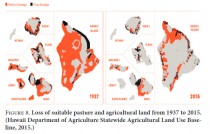
Enlarged
The single best thing I have seen written on fires in Maui comes not from a journalist, but from a BYU Hawaii undergrad, Kemana Ka’anapu, who has written a fascinating paper on Maui’s fire vulnerability. Ka’anapu shares the figure above and explains:
In the past two centuries, Hawaii has undergone an immense societal, economic, and environmental transformation that has resulted in a devastating wildfire problem. On examination of Hawaii’s history, we can see exactly how this development has occurred. In 1848, a feudal system of watershed-based land stewardship was replaced with an allodial system of land tenure that opened up the privatization of land.
From 1848 to 1937, over half of the land in Hawaii was transformed into pasture grazing land and plantation agriculture land. From 1937 to 2015, that amount of land decreased by over 62 percent, and over 90 percent of the remaining land suitable for ranching agriculture lands turned fallow and unmanaged. This land perfectly welcomed invasive grass and shrub plant species that have dominated and transformed Hawaiian ecosystems into fire- prone environments. These grasses and shrubs are the perfect fuel for fires and cover one-quarter of all Hawaiian lands. These grasses fuel a wildfire and fuel cycle with the help of high temperatures, dry climates, and human error.
Dan Sarewitz wrote almost a decade ago that “in addition to all the other things that climate change may be doing, it is also making us stupid”. Judged by climate journalism in 2023, he was not wrong.
Aug 04, 2023
The Media’s Climate Fearmongering Doesn’t Help Anyone
by Vijay Jayaraj
In an era of sensationalism and clickbait headlines, the media’s portrayal of hot weather adopts an apocalyptic tone. Each scorching summer is touted as further evidence of an impending climate catastrophe with little room for nuance or objective analysis.
However, lost in the hyperbole is the inconvenient truth that cold weather poses a far greater threat to human life than heat waves.
Human Body and Temperature
Contrary to popular media that make a bogeyman of warmth, humans possess physiological protections and have made behavioral adaptations that enable them to withstand and even thrive in warm weather.
Our bodies are equipped with efficient cooling mechanisms, such as sweating, which help regulate body temperature and prevent overheating. Additionally, humans have the ability to seek shelter from the sun and to hydrate to mitigate the effects of heat. In warm climates, societies have developed cultural practices and infrastructure to cope with high temperatures. Siestas, shaded outdoor spaces and cooling systems are examples.
In comparison, cold weather presents a more insidious and often overlooked threat. When temperatures plummet, the human body faces numerous challenges in maintaining its core temperature. Prolonged exposure to cold weather can lead to hypothermia, frostbite and other health complications.
Hypothermia occurs when the body’s core temperature drops below 95 degrees Fahrenheit. Frostbite is where the skin and underlying tissues freeze. Heart attacks are more common in cold weather because the organ has to work harder to pump blood.
The risks escalate in regions where infrastructure and societal adaptations to extreme cold are lacking. Inadequate heating systems, insufficient clothing, and limited access to warm shelters contribute to heightened vulnerability during cold spells.
Cold is a bigger killer than heat even in a tropical country like India, where summer temperatures can easily cross 104 degrees Fahrenheit every year. According to scientific studies, extreme temperature accounts for 6.5% of all deaths in India. Of that amount, 88% are caused by cold weather and only 12% by hot weather.
Researchers at King Abdullah University of Science and Technology say the reality of bigger risk from cold is “at odds with warnings and mitigating measures authorities have been taking in anticipation of climate change.”
Despite the overwhelming evidence of cold weather’s dangers, they often go unnoticed. Selective media coverage that tends to focus more on heat than cold perpetuates a distorted understanding of climate-related risks and hinders public discourse on comprehensive strategies to mitigate the dangers of frigid weather.
Manipulating People’s Minds
In addition, the media ignore or distort historical long-term trends that show the warmth of our current climate is neither unusual nor unprecedented.
For instance, we know that heat waves have become less frequent, shorter and less intense in the U.S. over the past 90 years. On June 27, 1915, Alaska registered a temperature of 100 degrees Fahrenheit at its Fort Yukon station. This year, it was just 66 degrees Fahrenheit.
In 1936, 8 states in the U.S. recorded temperatures over 120 degrees Fahrenheit, making that year’s July and August one of the hottest. Around 80 percent of U.S. states have their maximum temperature recorded prior to 1960. Across the pond, the UK registered monster heat waves in 1808.
Looking back even further, we know that Vikings grew barley on Greenland 1,000 years ago and that Romans cultivated citrus 2,000 years ago in northern England, neither of which is possible today.
In his book “Apocalypse Never,” Michael Shellenberger says, “The news media...deserves blame for having misrepresented climate change and other environmental problems as apocalyptic and for having failed to put them in their global, historical, and economic context.”
The media’s choice to misinform people about both historical data and the relative risks of heat and cold reveals a motive to promote climate fear.
This commentary was first published at The Hill, August 1, 2023.
Vijay Jayaraj is a Research Associate at the CO2 Coalition, Arlington, Virginia. He holds a master’s degree in environmental sciences from the University of East Anglia, UK and resides in India.
Jul 06, 2023
Hotter Than the Fourth of July???
CO2 Coalition
It was widely reported recently that July 4th, 2023 was the hottest day in Earth’s recorded history.
Paulo Ceppi, a climate scientist at London’s Grantham Institute stated: “It hasn’t been this warm since at least 125,000 years ago, which was the previous interglacial.” And, of course, it was reported that it was our fault due to our “sins of emission.”
This didn’t meet the smell test for the scientists at the CO2 Coalition. We know that previous warm periods were warmer than our modern temperatures. For example, during the Roman Warm Period there was citrus being grown in the north of England and barley was grown by Vikings on Greenland 1,000 years ago. Why aren’t they grown there now? It’s quite simple: Lower modern temperatures.
So, here at the CO2 Coalition, we did what scientists are trained to do:
We looked at the available data. Our Science and Research Associate Byron Soepyan reviewed temperature data from the US Historical Climatology Network and found that both the number of weather stations reporting temperature over 100 degrees F and the Maximum Average Temperature for July 4th were slightly declining since the record began in 1895 - not increasing - as Ceppi claimed.
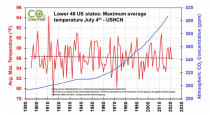
Enlarged
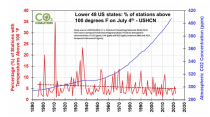
Enlarged
--------
Icecap notes:
The media and the alarmists jumped on forecasts for the hottest summer ever for the US and globe but it has been cold in Russia, India, China, and the US (warm in Canada) in June.
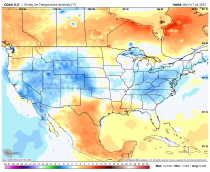
Enlarged
The warmists and their compliant media which had been all over the drought and heat in recent summers in the west, largely ignored the record snows in the. west where ski areas in California and Utah had as much as 900 inches of snow and skiing will continue into August.
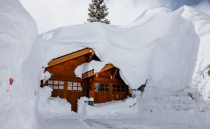
Enlarged
See the history of surface temperatures and how it has evolved from serious scientific study to political driven folly here
See the true heat story in detail here.
See this post reacting to total BS from the UN about the hottest ever summer.
Tony Heller shows it is actually in terms of extreme heat (100 degree temperatures), the coolest summer in the entire record.
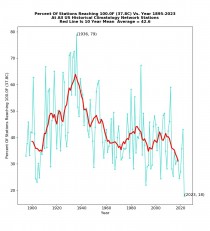
Enlarged
Jun 22, 2023
Global Wind Day, Environmental Nightmare
By Steve Milloy, June 16, 2023
June 15 was Global Wind Day. Its European industry sponsors hope to promote the “power and possibilities” of wind turbines. But beware the Ides of June.
Wind turbines have been sold to us as a means of reducing emissions, global warming and climate change. Although there are a lot of wind turbines installed around the world with many more seemingly to come, they have not reduced emissions, warming or climate change. And they offer no chance to do so, even if those things were desirable.
Coming eight days short of the 35th anniversary of James Hansen’s Senate testimony that sent the world into global warming panic, it’s clear to anyone who cares to look that emissions have nothing to do with recent warming.
Warming since 1980, has been driven by a series of El Nino events that have nothing to do with emissions. Since the last El Nino struck in 2015, the average global temperature has actually cooled slightly despite about 500 billion tons of emissions, which represent a 17 percent increase in industrial era atmospheric carbon dioxide (CO2).
While wind turbines offer no chance of improving the weather or climate, they require taxpayer subsidies and, even though subsidized, have raised electricity prices wherever they have been erected. Wind power has made Germans, for example, think of electricity as a luxury good. And you can trace the ongoing global energy crisis, inflation and even the Ukraine war to the rise of wind power.
But wind turbines are more than just an economic and geopolitical disaster. They are a menace to the environment.
Onshore wind turbines are well know wind turbines kill almost 900,000 bats per year. How green is that?
ICECAP NOTE: An estimated 140,000 to 500,000 birds die each year due to turbine collisions. Bird deaths could soar to 1.4 million per year if the U.S. Department of Energy achieves its goal of expanding wind energy to 20 percent of the country’s electricity demand by 2030.)
The Biden administration is now in the process of permitting the fast-track erection of offshore wind turbines. Although the erection of these 900-foot tall monsters (like a 90-story skyscraper) has not yet occurred, the mere process of site surveying is already wreaking havoc on whales, dolphins, porpoises and seals.
Since December 2022, more than two dozen dead whales have washed up on the New Jersey coast. These deaths have coincided with the commencement of surveying work for offshore wind turbines by foreign and U.S. developers.
While there is no video of the surveying work killing the whales and the Biden administration denies that it is happening, the inconvenient truth is that the government has permitted (in writing) wind developers to kill hundreds of whales, and thousands of dolphins, porpoises and seals.
Although there are only few hundred endangered North Atlantic Right Whales thought to exist, the Biden administration has permitted the wind developers to kill all of them - twice over. In a particularly cynical move, the Biden administration is currently trying to shut down the Maine lobster industry on the basis of a single North Atlantic Right Whale getting tangled in lobster gear 19 years ago.
None of the major green groups like Greenpeace have done anything but defend the wind industry and Biden administration regarding these marine-life deaths. In 1973, Greenpeace coined the phrase, “Save the Whales.” In 2023, it’s apparently been changed to “Kill the whales.” Orwell would love the irony.
Back on land, wind turbines are a permanently scarring feature. Past just being eyesores, each turbine requires an immense foundation of concrete and iron rebar that will be practically impossible to remove if anyone ever wishes to reclaim the land for more sensible use.
Germany’s 30,000 wind turbines are reportedly drying out the soil and contributing to drought, according to a new study.
In Germany and Britain where wind developers have been particularly aggressive, local populations are fighting back with zoning restrictions. So wind developers are looking to change zoning laws to force them down the throats of communities.
In the U.S., so-called “ESG” investors like JPMorgan Chase CEO Jamie Dimon have called for the government to seize land through eminent domain for wind turbines.
Iron Eyes Cody posed as the “Crying Indian” in the 1970s Keep American Beautiful campaign against litter. It’s time for another such campaign against the environmentally destructive wind industry. Just don’t count on the greens to support it. They are as phony as the Italian-born Cody was.
Steve Milloy is a senior legal fellow with the Energy and Environment Legal Institute.
|









